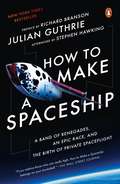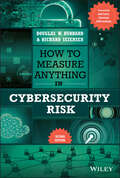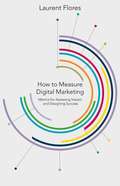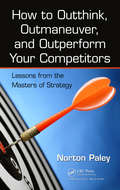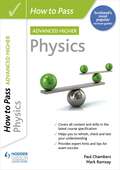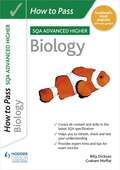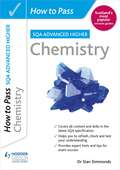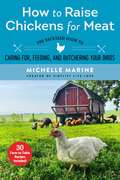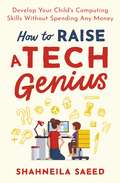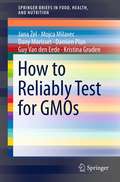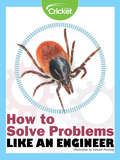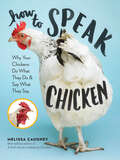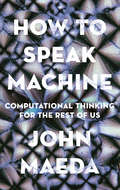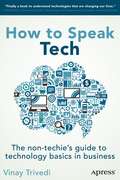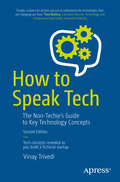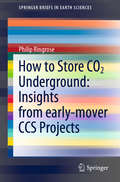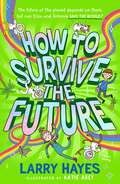- Table View
- List View
How to Make a Robot
by Gordon McCombLearn the basics of modern robotics while building your own intelligent robot from scratch! You'll use inexpensive household materials to make the base for your robot, then add motors, power, wheels, and electronics.But wait, it gets better: your creation is actually five robots in one! -- build your bot in stages, and add the features you want. Vary the functions to create a robot that's uniquely yours.Mix and match features to make your own custom robot:Flexible Motorized Base -- a playpen for all kinds of programming experimentsObstacle Detector -- whiskers detect when your robot has bumped into thingsObject Avoider -- ultrasonic sound lets your robot see what's in front of itInfrared Remote Control -- command your robot from your easy chairLine Follower -- use optics to navigate your bot; have races with other robot builders!You will learn how switches, ultrasonics, infrared detectors, and optical sensors work. Install an Arduino microcontroller board and program your robot to avoid obstacles, provide feedback with lights and sound, and follow a tracking line. In this book you will combine multiple disciplines -- electronics, programming, and engineering -- to successfully build a multifunctional robot.You'll discover how to:construct a motorized baseset up an Arduino to function as the brainuse "whisker" switches to detect physical contactavoid obstacles with ultrasonic sensorsteach your robot to judge distancesuse a universal remote to control your robotinstall and program a servo motorrespond to input with LEDs, buzzers, and tonesmount line-following sensors under your robotAnd more. Everything is explained with lots and lots of full-color line drawings. No prior experience is necessary. You'll have fun while you learn a ton!
How to Make a Spaceship: A Band of Renegades, an Epic Race, and the Birth of Private Spaceflight
by Stephen Hawking Richard Branson Julian GuthrieThe historic race that reawakened the promise of manned spaceflight. <p> Alone in a Spartan black cockpit, test pilot Mike Melvill rocketed toward space. He had eighty seconds to exceed the speed of sound and begin the climb to a target no civilian pilot had ever reached. He might not make it back alive. If he did, he would make history as the world’s first commercial astronaut. The spectacle defied reason, the result of a competition dreamed up by entrepreneur Peter Diamandis, whose vision for a new race to space required small teams to do what only the world’s largest governments had done before. <p><p>Peter Diamandis was the son of hardworking immigrants who wanted their science prodigy to make the family proud and become a doctor. But from the age of eight, when he watched Apollo 11 land on the Moon, his singular goal was to get to space. When he realized NASA was winding down manned space flight, Diamandis set out on one of the great entrepreneurial adventure stories of our time. If the government wouldn’t send him to space, he would create a private space flight industry himself. In the 1990s, this idea was the stuff of science fiction. Undaunted, Diamandis found inspiration in an unlikely place: the golden age of aviation. He discovered that Charles Lindbergh made his transatlantic flight to win a $25,000 prize. The flight made Lindbergh the most famous man on earth and galvanized the airline industry. Why, Diamandis thought, couldn’t the same be done for space flight? <p><p>The story of the bullet-shaped SpaceShipOne, and the other teams in the hunt, is an extraordinary tale of making the impossible possible. It is driven by outsized characters—Burt Rutan, Richard Branson, John Carmack, Paul Allen—and obsessive pursuits. In the end, as Diamandis dreamed, the result wasn’t just a victory for one team; it was the foundation for a new industry and a new age.
How to Make a Spaceship: A Band of Renegades, an Epic Race, and the Birth of Private Spaceflight
by Stephen Hawking Richard Branson Julian GuthrieThe historic race that reawakened the promise of manned spaceflight Alone in a Spartan black cockpit, test pilot Mike Melvill rocketed toward space. He had eighty seconds to exceed the speed of sound and begin the climb to a target no civilian pilot had ever reached. He might not make it back alive. If he did, he would make history as the world's first commercial astronaut. The spectacle defied reason, the result of a competition dreamed up by entrepreneur Peter Diamandis, whose vision for a new race to space required small teams to do what only the world's largest governments had done before. Peter Diamandis was the son of hardworking immigrants who wanted their science prodigy to make the family proud and become a doctor. But from the age of eight, when he watched Apollo 11 land on the Moon, his singular goal was to get to space. When he realized NASA was winding down manned space flight, Diamandis set out on one of the great entrepreneurial adventure stories of our time. If the government wouldn't send him to space, he would create a private space flight industry himself. In the 1990s, this idea was the stuff of science fiction. Undaunted, Diamandis found inspiration in an unlikely place: the golden age of aviation. He discovered that Charles Lindbergh made his transatlantic flight to win a $25,000 prize. The flight made Lindbergh the most famous man on earth and galvanized the airline industry. Why, Diamandis thought, couldn't the same be done for space flight? The story of the bullet-shaped SpaceShipOne, and the other teams in the hunt, is an extraordinary tale of making the impossible possible. It is driven by outsized characters--Burt Rutan, Richard Branson, John Carmack, Paul Allen--and obsessive pursuits. In the end, as Diamandis dreamed, the result wasn't just a victory for one team; it was the foundation for a new industry and a new age.From the Hardcover edition.
How to Measure Anything in Cybersecurity Risk
by Douglas W. Hubbard Richard SeiersenA start-to-finish guide for realistically measuring cybersecurity risk In the newly revised How to Measure Anything in Cybersecurity Risk, Second Edition, a pioneering information security professional and a leader in quantitative analysis methods delivers yet another eye-opening text applying the quantitative language of risk analysis to cybersecurity. In the book, the authors demonstrate how to quantify uncertainty and shed light on how to measure seemingly intangible goals. It's a practical guide to improving risk assessment with a straightforward and simple framework. Advanced methods and detailed advice for a variety of use cases round out the book, which also includes: A new "Rapid Risk Audit" for a first quick quantitative risk assessment. New research on the real impact of reputation damage New Bayesian examples for assessing risk with little data New material on simple measurement and estimation, pseudo-random number generators, and advice on combining expert opinion Dispelling long-held beliefs and myths about information security, How to Measure Anything in Cybersecurity Risk is an essential roadmap for IT security managers, CFOs, risk and compliance professionals, and even statisticians looking for novel new ways to apply quantitative techniques to cybersecurity.
How to Measure Digital Marketing: Metrics for Assessing Impact and Designing Success
by Laurent FlorésMeasuring the Success of Digital Marketing explains how to determine the success of a digital marketing campaign by demonstrating what digital marketing metrics are as well as how to measure and use them. Including real life case studies and experts viewpoints that help marketers navigate the digital world.
How to Outthink, Outmaneuver, and Outperform Your Competitors: Lessons from the Masters of Strategy
by Norton PaleySupplying you with a firm grasp of the roots of strategy, How to Outthink, Outmaneuver, and Outperform Your Competitors: Lessons from the Masters of Strategy explains how to develop the skills and strategies needed to compete in today’s volatile marketplace. It interweaves the classic works of the masters of strategy, such as Sun Tzu, Carl von Clausewitz, Mao Tse-tung, Niccolo Machiavelli, Frederick the Great, Napoleon, and other renowned strategists.The collective insights of these legendary strategists span 2,500 of combative history and have survived meticulous analysis by scholars. Applied to current competitive business conditions, their time-tested rules and guidelines will prepare you to deal with such issues as: preventing competitors from disrupting your overall growth plans, protecting yourself from a rival’s take-over strategies, and strengthening long-term customer relationships.Whether you operate as a multinational firm maneuvering for position in a global arena, or a regional business fighting an everyday battle for survival, the foundational principles provided can reinforce your understanding and practice of strategy. The book defines the historical origins of strategy and supplies timeless insight into how successful leaders have implemented comprehensive strategy plans. It also explains how to: Maneuver out of risky competitive situations and into renewed market opportunities Establish a defensible position in a hotly-contested market Apply competitive business techniques to outperform your rivals Align competitive strategies with your organization’s culture Personalize a leadership style to maximize performance from your staff The book includes three special features: Strategy Diagnostic Tool—A structured system to help you assess your firm’s competitiveness before committing valuable resources. Appraising Internal and External Conditions—A comprehensive checklist to analyze those key factors that can determine the success of your business plan. Strategy Action Plan—A tested format that includes step-by-step guidelines to develop a personalized business plan. The lessons gleaned from military history and strategy can be indispensable in the everyday management of your people and resources. By tapping into the universal logic and historic lessons of strategy, you will fortify your ability to think like a master strategist and add greater precision to your decision-making—thereby allowing you to outthink, outmaneuver, and outperform your competition.
How to Pass Advanced Higher Physics
by Paul Chambers Mark RamsayExam board: SQALevel: Advanced HigherSubject: PhysicsFirst teaching: August 2019First exam: Summer 2021Trust Scotland's most popular revision guides to deliver the results you want. The How to Pass series is chosen by students, parents and teachers again and again.This is the only study book that addresses the skills for Advanced Higher Physics, as well as the knowledge.> Recap and remember course content. Concise summaries and diagrams cover the important points for each topic in the latest specification.> Test your skills and knowledge. Regular examples with worked solutions help you to see if a topic is secure before you move on. This style of active revision is much more effective than simply reading.> Practise exam-style questions. Formal questions with mark allocations are provided at the end of each topic, reflecting the types of questions you will face in the exam.> Get expert tips for exam success. Hints on how to achieve top marks and avoid mistakes are based on feedback in the examiners' Course Reports, giving you insight into the marking process.> Teach yourself with confidence. Independent study has never been easier with clear explanations, definitions of technical terms and answers to all questions at the back of the book.> Plan and manage your revision. Checklists for each topic enable you to benchmark your progress against the assessment standards and make sure you're on track to get the grades you need
How to Pass SQA Advanced Higher Biology
by Graham Moffat Billy DicksonExam board: SQALevel: Advanced HigherSubject: BiologyFirst teaching: August 2019First exam: Summer 2021Trust Scotland's most popular revision guides to deliver the results you want. The How to Pass series is chosen by students, parents and teachers again and again.This is the only study book that addresses the skills for Advanced Higher Biology, as well as the knowledge.> Recap and remember course content. Concise summaries and diagrams cover the important points for each Key Area in the latest SQA specification.> Test your skills and knowledge. Regular 'check-up' questions throughout the text help you to see if a topic is secure before you move on. This style of active revision is much more effective than simply reading.> Practise exam-style questions. Formal questions with mark allocations are provided at the end of each Key Area, reflecting the types of questions you will face in the exam. Three course assessments are also included.> Get expert tips for exam success. Hints on how to achieve top marks and avoid mistakes are based on feedback in the SQA examiners' Course Reports, giving you insight into the marking process.> Teach yourself with confidence. Independent study has never been easier with clear explanations, definitions of technical terms and answers to all questions at the back of the book.> Plan and manage your revision. Checklists for each Key Area enable you to benchmark your progress against SQA's assessment standards and make sure you're on track to get the grades you need.
How to Pass SQA Advanced Higher Biology
by Graham Moffat Billy DicksonExam board: SQALevel: Advanced HigherSubject: BiologyFirst teaching: August 2019First exam: Summer 2021Trust Scotland's most popular revision guides to deliver the results you want. The How to Pass series is chosen by students, parents and teachers again and again.This is the only study book that addresses the skills for Advanced Higher Biology, as well as the knowledge.> Recap and remember course content. Concise summaries and diagrams cover the important points for each Key Area in the latest SQA specification.> Test your skills and knowledge. Regular 'check-up' questions throughout the text help you to see if a topic is secure before you move on. This style of active revision is much more effective than simply reading.> Practise exam-style questions. Formal questions with mark allocations are provided at the end of each Key Area, reflecting the types of questions you will face in the exam. Three course assessments are also included.> Get expert tips for exam success. Hints on how to achieve top marks and avoid mistakes are based on feedback in the SQA examiners' Course Reports, giving you insight into the marking process.> Teach yourself with confidence. Independent study has never been easier with clear explanations, definitions of technical terms and answers to all questions at the back of the book.> Plan and manage your revision. Checklists for each Key Area enable you to benchmark your progress against SQA's assessment standards and make sure you're on track to get the grades you need.
How to Pass SQA Advanced Higher Chemistry
by Dr Sian SimmondsExam board: SQALevel: Advanced HigherSubject: ChemistryFirst teaching: August 2019First exam: Summer 2021Trust Scotland's most popular revision guides to deliver the results you want. The How to Pass series is chosen by students, parents and teachers again and again.This is the only study book that addresses the skills for Advanced Higher Chemistry, as well as the knowledge.> Recap and remember course content. Concise summaries and diagrams cover the important points for each Key Area in the latest SQA specification.> Test your skills and knowledge. Regular 'check-up' questions throughout the text help you to see if a topic is secure before you move on. This style of active revision is much more effective than simply reading.> Practise exam-style questions. Formal questions with mark allocations are provided at the end of each Key Area, reflecting the types of questions you will face in the exam.> Get expert tips for exam success. Hints on how to achieve top marks and avoid mistakes are based on feedback in the SQA examiners' Course Reports, giving you insight into the marking process.> Teach yourself with confidence. Independent study has never been easier with clear explanations, definitions of technical terms and answers to all questions at the back of the book.> Plan and manage your revision. Checklists for each Key Area enable you to benchmark your progress against SQA's assessment standards and make sure you're on track to get the grades you need.
How to Pass SQA Advanced Higher Chemistry
by Sian SimmondsExam board: SQALevel: Advanced HigherSubject: ChemistryFirst teaching: August 2019First exam: Summer 2021Trust Scotland's most popular revision guides to deliver the results you want. The How to Pass series is chosen by students, parents and teachers again and again.This is the only study book that addresses the skills for Advanced Higher Chemistry, as well as the knowledge.> Recap and remember course content. Concise summaries and diagrams cover the important points for each Key Area in the latest SQA specification.> Test your skills and knowledge. Regular 'check-up' questions throughout the text help you to see if a topic is secure before you move on. This style of active revision is much more effective than simply reading.> Practise exam-style questions. Formal questions with mark allocations are provided at the end of each Key Area, reflecting the types of questions you will face in the exam.> Get expert tips for exam success. Hints on how to achieve top marks and avoid mistakes are based on feedback in the SQA examiners' Course Reports, giving you insight into the marking process.> Teach yourself with confidence. Independent study has never been easier with clear explanations, definitions of technical terms and answers to all questions at the back of the book.> Plan and manage your revision. Checklists for each Key Area enable you to benchmark your progress against SQA's assessment standards and make sure you're on track to get the grades you need.
How to Pass SQA Advanced Higher Physics
by Paul Chambers Mark RamsayExam board: SQALevel: Advanced HigherSubject: PhysicsFirst teaching: August 2019First exam: Summer 2021Trust Scotland's most popular revision guides to deliver the results you want. The How to Pass series is chosen by students, parents and teachers again and again.This is the only study book that addresses the skills for Advanced Higher Physics, as well as the knowledge.> Recap and remember course content. Concise summaries and diagrams cover the important points for each Key Area in the latest SQA specification.> Test your skills and knowledge. Regular 'check-up' questions throughout the text help you to see if a topic is secure before you move on. This style of active revision is much more effective than simply reading.> Practise exam-style questions. Formal questions with mark allocations are provided at the end of each Key Area, reflecting the types of questions you will face in the exam.> Get expert tips for exam success. Hints on how to achieve top marks and avoid mistakes are based on feedback in the SQA examiners' Course Reports, giving you insight into the marking process.> Teach yourself with confidence. Independent study has never been easier with clear explanations, definitions of technical terms and answers to all questions at the back of the book.> Plan and manage your revision. Checklists for each Key Area enable you to benchmark your progress against SQA's assessment standards and make sure you're on track to get the grades you need.
How to Raise Chickens for Meat: The Backyard Guide to Caring for, Feeding, and Butchering Your Birds
by Michelle MarineIf self-sufficiency and raising your own food is important to you, this book will help you pull together a complete farm-to-table experience. Gone are the days when grandma headed to the chicken coop in search of dinner. In this day and age, when fewer and fewer people know where their food comes from, How to Raise Chickens for Meat helps families take control of their food supply once again. Divided into four easy-to-navigate sections,How to Raise Chickens for Meat is packed with practical information. The first section, Getting Started, includes information on breed specifics, timing, and quantity. This section will help you analyze options and make informed decisions as you get started. The second section, Care & Feeding, dives into the specifics of keeping your flock healthy. Learn how to set up a brooder, what to feed your chickens, how to safely pasture them, and how to keep your flock stress-free. The third section, Butchering, prepares you for one of the more challenging parts of raising chickens for meat. It addresses some of the emotions you may feel along with the actual process of butchering and provides practical tips to make it easier. It also discusses alternative options if you don&’t want to process your own chickens. The book concludes with cooking tips and delicious tried and true farm-to-table recipes to impress even the most doubtful family member! How to Raise Chickens for Meat is the resource your homestead library has been missing.
How to Raise a Tech Genius: Develop Your Child's Computing Skills Without Spending Any Money
by Shahneila SaeedTeach computing concepts without computers! How to Raise a Tech Genius makes the computing curriculum accessible for parents and families.We live in a digital world - one in which our children are surrounded by technology. It's a part of their lives in a way that even the most tech-savvy adults aren't fully able to comprehend. What we do know is that the workplace of tomorrow will require our children to harness the power behind the technology, to be able to understand key concepts and apply them. Logical reasoning, creativity and problem solving are skills that are becoming increasingly essential in the world of work. How can we best prepare our children to enter this world? How to Raise a Tech Genius is a practical book that assumes no prior knowledge or understanding of computing and enables parents to learn skills and concepts alongside their children. The quick, easy and fun fifteen-minute activities within the book have been developed using first-hand teaching expertise and are fully mapped to the computing curriculum taught in schools. From a deck of playing cards to the story books on your bookshelf or even the contents of your fridge, How to Raise a Tech Genius uses everyday objects that can be found around your home to illustrate core computer science concepts. Children and adults alike will enjoying playing games while developing their algorithmic thinking and logical reasoning skills. This book demystifies the computing curriculum for adults, showing parents a whole new side of computing, coding and technology so that they can help their child become a computing genius!
How to Raise a Tech Genius: Develop Your Child's Computing Skills Without Spending Any Money
by Shahneila SaeedTeach computing concepts without computers! How to Raise a Tech Genius makes the computing curriculum accessible for parents and families.We live in a digital world - one in which our children are surrounded by technology. It's a part of their lives in a way that even the most tech-savvy adults aren't fully able to comprehend. What we do know is that the workplace of tomorrow will require our children to harness the power behind the technology, to be able to understand key concepts and apply them. Logical reasoning, creativity and problem solving are skills that are becoming increasingly essential in the world of work. How can we best prepare our children to enter this world? How to Raise a Tech Genius is a practical book that assumes no prior knowledge or understanding of computing and enables parents to learn skills and concepts alongside their children. The quick, easy and fun fifteen-minute activities within the book have been developed using first-hand teaching expertise and are fully mapped to the computing curriculum taught in schools. From a deck of playing cards to the story books on your bookshelf or even the contents of your fridge, How to Raise a Tech Genius uses everyday objects that can be found around your home to illustrate core computer science concepts. Children and adults alike will enjoying playing games while developing their algorithmic thinking and logical reasoning skills. This book demystifies the computing curriculum for adults, showing parents a whole new side of computing, coding and technology so that they can help their child become a computing genius!
How to Reliably Test for GMOs
by Dany Morisset Kristina Gruden Damien Plan Jana Žel Mojca Milavec Guy Van den EedeThe detection of genetically modified organisms (GMOs) is becoming very complex, with new GMOs, approved and unapproved, constantly entering world markets. Traceability and labelling of GMOs is defined in regulations worldwide, demanding accurate and reliable testing to support the requirements of legislation. This Brief provides the current state-of-the-art on all key topics involved in GMO testing and is a source of detailed practical information for laboratories. Special focus is given to qualitative and quantitative real-time PCR analysis relevant to all areas where detection and identification rely on nucleic acid-based methods. The following topics, important for testing laboratories, are also discussed: organization of the laboratory, focusing on aspects of the quality system and methods for testing, validation and verification of methods, and measurement uncertainty. The Brief also discusses the new challenges of GMOs and novel modified organisms, using new technologies, and the possible solutions for GMO detection, including bioinformatics tools. Finally, legislation on GMOs and sources of information on GMOs are provided, which are relevant not only to testing laboratories, but to anyone interested in GMOs. The authors of this Brief have many years of experience in GMO testing, development of real-time PCR methods, implementation of quality system requirements, validations and verification of methods, and measurement uncertainty. The National Institute of Biology is a highly qualified research laboratory and a National Reference Laboratory, which also performs routine analyses of food, feed and seed. The Institute for Health and Consumer Protection of the European Union Joint Research Centre has extensive knowledge and experience of GMO detection. It hosts the European Union Reference Laboratory for GM Food and Feed in addition to chairing the European Network of GMO Laboratories.
How to Solve Problems Like an Engineer
by Mary Beth CoxSome everyday problems can be solved using a series of steps called the Engineering Design Process.
How to Speak Chicken: Why Your Chickens Do What They Do & Say What They Say
by Melissa CaugheyBest-selling author Melissa Caughey knows that backyard chickens are like any favorite pet — fun to spend time with and fascinating to observe. Her hours among the flock have resulted in this quirky, irresistible guide packed with firsthand insights into how chickens communicate and interact, use their senses to understand the world around them, and establish pecking order and roles within the flock. Combining her up-close observations with scientific findings and interviews with other chicken enthusiasts, Caughey answers unexpected questions such as Do chickens have names for each other? How do their eyes work? and How do chickens learn? Foreword INDIES Silver Award Winner
How to Speak Machine: Computational Thinking for the Rest of Us
by John MaedaVisionary designer and technologist John Maeda defines the fundamental laws of how computers think, and why you should care even if you aren't a programmer."Maeda is to design what Warren Buffett is to finance." --WiredJohn Maeda is one of the world's preeminent interdisciplinary thinkers on technology and design. In How to Speak Machine, he offers a set of simple laws that govern not only the computers of today, but the unimaginable machines of the future. Technology is already more powerful than we can comprehend, and getting more powerful at an exponential pace. Once set in motion, algorithms never tire. And when a program's size, speed, and tirelessness combine with its ability to learn and transform itself, the outcome can be unpredictable and dangerous. Take the seemingly instant transformation of Microsoft's chatbot Tay into a hate-spewing racist, or how crime-predicting algorithms reinforce racial bias.How to Speak Machine provides a coherent framework for today's product designers, business leaders, and policymakers to grasp this brave new world. Drawing on his wide-ranging experience from engineering to computer science to design, Maeda shows how businesses and individuals can identify opportunities afforded by technology to make world-changing and inclusive products--while avoiding the pitfalls inherent to the medium.
How to Speak Tech
by Vinay Trivedi"A great book everyone can use to understand how tech startups work. " --Rene Reinsberg, GM/VP at GoDaddy, CEO and Co-founder at Locu "Finally a book non-techies can use to understand the web technologies that are changing our lives. " --Paul Bottino, Executive Director, Technology and Entrepreneurship Center, Harvard University "Through the simplicity of his presentation, Vinay shows that the basics of technology can be straightforwardly understood by anyone who puts in the time and effort to learn. " --Joseph Lassiter, Professor of Management Science, Harvard Business School and Harvard Innovation Lab In a way that anyone can understand, How to Speak Tech: The Non-Techie''s Guide to Tech Basics in Business spells out the essential technical terms and technologies involved in setting up a company''s website or web application. Nontechnical business readers will find their digital literacy painlessly improved with each ten-minute chapter of this illustrative story of one successful technology startup building its Web-based business from scratch. Vinay Trivedi--a private equity analyst and startup entrepreneur who works at the intersection of business and tech--employs the startup story line as his frame for explaining in plain language the technology behind our daily user experiences, the successful strategies of social media giants, the bold aspirations of tiny startups, and the competitive adaptations of ordinary businesses of all sizes and sectors. Along the way, he demystifies all those tech buzzwords in our business culture whose precise meanings are so often elusive even to the people using them. Internet hardware, application software, and business process: the working premise of this book is that none of it is beyond the basic understanding of nontechnical business readers. Trivedi peels back the mystery, explains it all in simplest terms, and gives his readers the wherewithal to listen intelligently and speak intelligibly when the subject turns to technology in business. What you''ll learn Website hosts and programming languages for web apps on the backend Performance and scalability APIs, open-source programs, feeds, and database management Design and display on the front end Who this book is for Primary readership: nontechnical business people who want to firm up their understanding of the technology of the Internet and their fluency with technical terms in widespread use in the business world. Secondary readership: Digital immigrants in the general-interest mainstream who are looking for a short, accessible, and comprehensive treatment of Internet technology and business to inform their personal experience as consumers and generators of Internet content and value. Table of Contents Chapter 1. The Internet Chapter 2. Hosting and the Cloud Chapter 3. The Back End: Programming Languages Chapter 4. The Front End: Presentation Chapter 5. Databases: The Model Chapter 6. Leveraging Existing Code: APIs, Libraries, Web Services, and Open-Source Projects Chapter 7. Software Development: Working in Teams Chapter 8. Software Development: The Process Chapter 9. Software Development: Debugging and Testing Chapter 10. Promotion and Tracking: Attracting and Understanding Your Users Chapter 11. Performance and Scalability Chapter 12. Security Threats: To Defend and Protect
How to Speak Tech: The Non-Techie’s Guide to Key Technology Concepts
by Vinay TrivediThings you’ve done online: ordered a pizza, checked the weather, booked a hotel, and reconnected with long-lost friends. Now it’s time to find out how these things work. Vinay Trivedi peels back the mystery of the Internet, explains it all in the simplest terms, and gives you the knowledge you need to speak confidently when the subject turns to technology. This revised second edition of How to Speak Tech employs the strategy of the popular first edition: through the narrative of setting up a fictitious startup, it introduces you to essential tech concepts. New tech topics that were added in this edition include the blockchain, augmented and virtual reality, Internet of Things, and artificial intelligence.The author’s key message is: technology isn’t beyond the understanding of anyone! By breaking down major tech concepts involved with a modern startup into bite-sized chapters, the author’s approach helps you understand topics that aren’t always explained clearly and shows you that they aren’t rocket science. So go ahead, grab this book, start to “speak tech,” and hold your own in any tech-related conversation!What You'll LearnUnderstand the basics of new and established technologies such as blockchain, artificial intelligence (AI), augmented and virtual reality (AR and VR), Internet of Things (IoT), software development, programming languages, databases, and moreListen intelligently and speak confidently when technologies are brought up in your businessBe confident in your grasp of terms and technologies when setting up your own organization's applicationWho This Book Is ForStudents who want to understand different technologies relevant to their future careers at startups and established organizations, as well as business and other non-technical professionals who encounter and require an understanding of key technical terms and trends to succeed in their rolesReviews“Finally, a book non-techies can use to understand the technologies that are changing our lives.” Paul Bottino, Executive Director, Technology and Entrepreneurship Center, Harvard University“A great book everyone can use to understand how tech startups work.” Rene Reinsberg, Founder at Celo; Former VP of Emerging Products, GoDaddy“Through the simplicity of his presentation, Vinay shows that the basics of technology can be straightforwardly understood by anyone who puts in the time and effort to learn.” Joseph Lassiter, Professor of Management Science, Harvard Business School and Harvard Innovation Lab
How to Spy on a Shark
by Lori Haskins Houran Francisca MarquezSpend a day at sea tracking sharks--with the help of a robot! How do you spy on a shark? Join a team of marine biologists as they head out in their boat to study mako sharks. They catch, tag, and release a young mako, then follow it with a special robot that can track the shark on video! Simple, entertaining text and bright, accurate illustrations bring science and technology to life, and additional pages of facts about sharks follow the story. The latest book in this read-aloud science series is bound to make a splash with young minds! This is a fixed-format ebook, which preserves the design and layout of the original print book.
How to Stop a Hijacking: Critical Thinking in Civil Aviation Security
by Clay W. BilesHijackings and bombings have plagued civil aviation since 1930 and air rage incidents are on the rise. While there is aircraft and inflight training available for air marshals, other first responders receive minimal training on inflight security awareness and protocols. There are no other resources currently available to flight crews or armed first responders that specifically address inflight security and how to address threats of disturbances on airplanes.How to Stop a Hijacking provides readers with fundamental principles on how to think more critically about onboard security threats. The aircraft cabin poses unique environment and security challenges, and first responders can apply security awareness and critical thinking skills to establish a safer environment in the cabin and airport for everyone onboard. The lessons in this book are driven with the central objective of teaching the reader how to counter inflight aggression and maintain tactical control of the cabin. Written by a former federal air marshal instructor, this book looks at the recent rash of air rage incidents and violence on airplanes, in addition to the real and ever-present threat of hijack or potential explosive device.How to Stop a Hijacking is a practical guide that offers methodological and tactically proven strategies for stopping violent acts onboard an aircraft inflight.
How to Store CO2 Underground: Insights from early-mover CCS Projects (SpringerBriefs in Earth Sciences)
by Philip RingroseThis book introduces the scientific basis and engineering practice for CO2 storage, covering topics such as storage capacity, trapping mechanisms, CO2 phase behaviour and flow dynamics, engineering and geomechanics of geological storage, injection well design, and geophysical and geochemical monitoring. It also provides numerous examples from the early mover CCS projects, notably Sleipner and Snøhvit offshore Norway, as well as other pioneering CO2 storage projects.
How to Survive The Future (How to Survive #3)
by Larry HayesGet ready for a hilarious out-of-this-world adventure for readers aged 8+ – this is the perfect new series for fans of Tom Gates, Andy Griffiths and Star Wars! Illustrated throughout by the brilliantly funny Katie Abey. *PRE-ORDER NOW!* It&’s the year 2525, and things aren&’t looking great for Planet Earth. An endless night is coming – a super-advanced alien spaceship has stopped the world from turning, threatening the existence of every creature on the planet – and it turns out that ten-year-old Eliza Lemon is the only one who can save them! Will she be able to handle alien overlords, a doughnut-shaped spaceship, monkeys and vampire finches? And, most importantly of all, will she be able to rescue her baby brother, save the world and survive THE FUTURE?For more out-of-this-world fun don't forget to read about Eliza and Johnnie's first two adventures in How to Survive Without Grown-Ups and How to Survive Time Travel. Out now!

